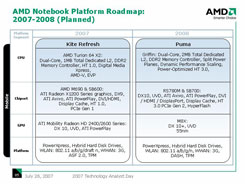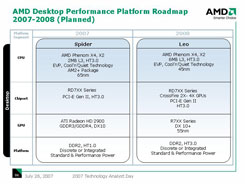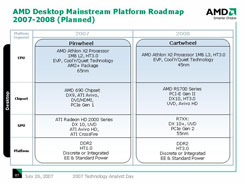
AMD looks set to introduce graphics cards with the new DisplayPort interface as early as next year, according to roadmaps released by the company at this year’s Analyst’s Day event.
DisplayPort was approved by VESA in April this year and both Dell and Samsung have discussed LCDs using the new connection interface. However, in order to use these displays, you’ll need a graphics card with a DisplayPort connector.
This is where AMD’s next-generation R7xx-series graphics cards come into play, as the company discussed implementing the connection interface into its graphics cards next year.
Looking over the company’s roadmaps with a closer eye reveals some potentially interesting facts about the R7xx series of graphics processing units. Currently, AMD is planning to use a 55nm manufacturing process on both its performance, mainstream and mobile GPUs – this should hopefully resolve the high power consumption problems AMD’s Radeon HD 2900 XT has suffered from.
Potentially more controversially though is the fact that, like the current situation, the company’s Unified Video Decoder doesn’t look like it’s going to be a feature on the more performance-orientated SKUs. Additionally, the second generation PCI-Express interface isn’t listed on the performance roadmap, but is on the mainstream roadmap – could it be that AMD’s next-generation high-end GPUs will not use the new bus technology?
The reasons, I guess are the fact that the high-end GPUs use a pair of internal CrossFire bridges for inter-GPU communications in multi-GPU mode. On the other hand, the more mainstream-orientated GPUs will pass all data over the PCI-Express bus, thus explaining the need for more bandwidth. Of course, the increased bandwidth isn’t the only new feature in PCIe 2.0, as there are the increased power figures too.
Some of this looks strange, and I guess we won't know the real answers until sometime next year when we have the hardware in hand. Do you think some of AMD's plans are strange? Share your thoughts in the forums.
DisplayPort was approved by VESA in April this year and both Dell and Samsung have discussed LCDs using the new connection interface. However, in order to use these displays, you’ll need a graphics card with a DisplayPort connector.
This is where AMD’s next-generation R7xx-series graphics cards come into play, as the company discussed implementing the connection interface into its graphics cards next year.
Looking over the company’s roadmaps with a closer eye reveals some potentially interesting facts about the R7xx series of graphics processing units. Currently, AMD is planning to use a 55nm manufacturing process on both its performance, mainstream and mobile GPUs – this should hopefully resolve the high power consumption problems AMD’s Radeon HD 2900 XT has suffered from.
Potentially more controversially though is the fact that, like the current situation, the company’s Unified Video Decoder doesn’t look like it’s going to be a feature on the more performance-orientated SKUs. Additionally, the second generation PCI-Express interface isn’t listed on the performance roadmap, but is on the mainstream roadmap – could it be that AMD’s next-generation high-end GPUs will not use the new bus technology?
The reasons, I guess are the fact that the high-end GPUs use a pair of internal CrossFire bridges for inter-GPU communications in multi-GPU mode. On the other hand, the more mainstream-orientated GPUs will pass all data over the PCI-Express bus, thus explaining the need for more bandwidth. Of course, the increased bandwidth isn’t the only new feature in PCIe 2.0, as there are the increased power figures too.
Some of this looks strange, and I guess we won't know the real answers until sometime next year when we have the hardware in hand. Do you think some of AMD's plans are strange? Share your thoughts in the forums.

MSI MPG Velox 100R Chassis Review
October 14 2021 | 15:04











Want to comment? Please log in.